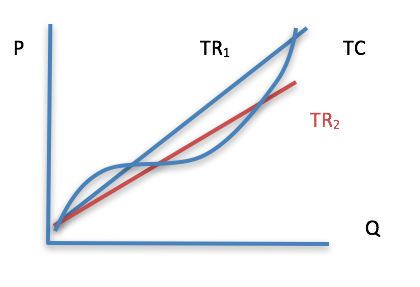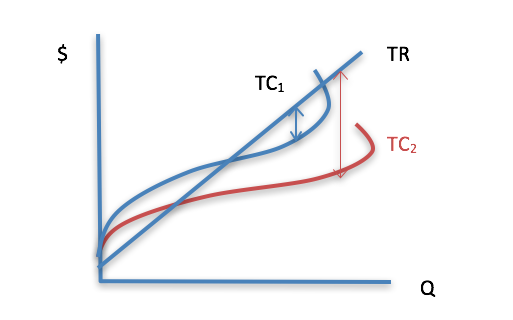Let’s look at the news to see how these ideas play out in the “real world.” The following article comes from The Progressive Farmer and was written by Elizabeth Williams. You can click on the image to get the whole story.

Figure 5-7: Screenshot of news article predicting poor farm income. Source: https://www.dtnpf.com/agriculture/web/ag/news/business-inputs/article/2016/09/27/costs-fail-match-plunge-revenues. Permission: This material has been reproduced in accordance with the University of Saskatchewan interpretation of Sec.30.04 of the Copyright Act.
The author points out two concerns for farmers: both alluded to in the title of the article. One concern is “the plunge in revenue,” which would likely be caused by a decrease in prices. The second problem for farmers is that they couldn’t keep costs down. If we were to illustrate this using the analysis from above,

Figure 5-8: Reduction in TR resulting in reduction in profit. Permission: Courtesy of course author Hayley Hesseln, Department of Agriculture and Resource Economics, University of Saskatchewan.
what do you suppose it would look like?
First, we would have to show a reduction in prices. A lower price would make total revenue lower, or in the case of the total revenue curve, flatter.
The original profit (farm income in the article) would be the difference between TR1 and TC (the two blue lines). The new profit/farm income would be much smaller as reflected by the difference between TC and the new TR2, which is much lower/flatter.
The article also mentioned that farmers weren’t able to reduce costs. If they had, the TC curve might also shift downward, thus improving the profit potential.
Anytime prices fall, profits will fall. The reverse is true for costs. When both factors are changing, it’s important to determine the magnitude of the changes. Without knowing how much costs and prices are changing, it’s difficult to predict whether profits will fall or rise.
What happens when technology improves the production process? How might this be reflected in changing profitability? It’s fairly intuitive when you think about the story. The government and companies invest in science and technology to improve outputs or the quality of the output. We know that we sell output at a certain price to generate revenue. Also, if we improve the quality of a good/service, we can get a higher price.
So, let’s begin with an example from the Institute of Food Technologies.

Figure 5-9: Screenshot of IFT prediction that technology will increase yield. Source: https://www.ifpri.org/news-release/agricultural-technologies-could-increase-global-crop-yields-much-67-percent-and-cut#:~:text=New%20study%20identifies%20most%20promising%20agricultural%20tools%20for%20feeding%20the%20world's%20poorest&text=No%2Dtill%20farming%20alone%20could,by%2067%20percent%20in%202050. Permission: This material has been reproduced in accordance with the University of Saskatchewan interpretation of Sec.30.04 of the Copyright Act.
The IFT in Chicago, predicts crop yields will increase as a result of innovative production processes. The way to illustrate this improvement and to estimate what would happen in terms of business, is to begin with the production function as we did in Module 4.

Figure 5-10: Increase in physical yield in graph 1 leads to decrease in cost in graph 2. Permission: Courtesy of course author Hayley Hesseln, Department of Agriculture and Resource Economics, University of Saskatchewan.
When we add total revenue, we see that the profit increases and that we reach the break-even point sooner in production. You’ll note that the difference between TR and TC2 is greater than the difference between TR and TC1.

Figure 5-11: Illustration of the increase in profits as a result of technological improvements that reduce costs. Permission: Courtesy of course author Hayley Hesseln, Department of Agriculture and Resource Economics, University of Saskatchewan.
